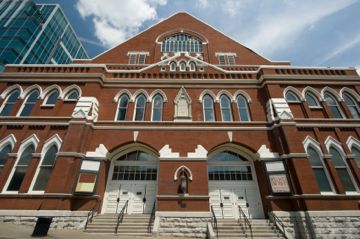How High Was the Water, Mama?
Tom Swick: After the flood, Nashville sings its way out of trouble
07.06.10 | 12:07 PM ET
 Nashville’s Ryman Auditorium (iStockPhoto)
Nashville’s Ryman Auditorium (iStockPhoto)My room at the stylish Hutton Hotel had two magazines: Nashville and American Songwriter. The first featured on its cover country music singer Julie Roberts dressed in a black T-shirt with the three stars of the Tennessee flag bobbing in a circle of water. Below the circle were the words: “Rebuild Nashville, Tennessee—2010 Flood.”
Inside, Roberts wrote of all she had lost but mostly about the outpouring of help, including a donation of clothes so that she could perform.
I went out to see the city. On the elevator a voice devoid of any trace of a Southern accent said, somewhat ominously: “Going down.”
Downtown showed little evidence of the inundation that occurred the first weekend of May, killing dozens of people and causing an estimated $1 billion of damage. Repairs were ongoing at the Schermerhorn Symphony Center, and the theater at the Country Music Hall of Fame and Museum was temporarily closed.
But girls were line-dancing at the recently reopened Wildhorse Saloon, which overlooks the Cumberland River (and serves up baskets of crunchy fried pickles). And the dreaming street musicians had returned to the sidewalks of Lower Broadway. The honky-tonks along this street, places like Tootsies Orchid Lounge and Legends Corner, had been untouched by water but not the event; business had suffered because people had been told to stay away from downtown.
The Ryman Auditorium rose impervious on its slope behind the honky-tonks, and warm summer crowds filed inside for Bluegrass Night. The pews (the Ryman was built as a tabernacle) were filled by the time announcer Eddie Stubbs appeared onstage. In a sharp gray suit and a deep smooth voice, Stubbs described the night’s headliner—Vince Gill—as “one of the greatest humanitarians this city has ever seen.” (Roberts wrote of participating in the “Vince Gill and Friends Telethon.”)
After a rollicking set of bluegrass, Gill sang some country songs, including “The Lonesome River.” “I dedicate it to the Cumberland,” he said in introduction. “I don’t really like the Cumberland much,” he added, to understanding chuckles, before mentioning that he had lost over 100 instruments in the flood. He said that, while he was mourning this loss, his wife (Amy Grant) had put her arm around him and said: “You know what? You can make a living with one.”
In the morning I took the elevator—“Going down”—to breakfast, where my waiter, Nathaniel, talked of his dream to one day write scores for TV and movies. (I had heard that 70 percent of the wait staff in Nashville hopes to break into the music business.)
I headed back to the Ryman for a backstage tour. It is possibly the only building in the world that stands as the sole embodiment of a musical genre. Called “The Mother Church of Country Music,” it is also considered the birthplace of bluegrass, having hosted Bill Monroe and his Blue Grass Boys on its stage in December 1945. From 1943 to 1974 it was the home of the Grand Ole Opry (before the show’s move to Opryland). This year the Opry is celebrating its 85th anniversary.
The dressing rooms were hung with winsome, folk art portraits. “Hank Williams—Mr. Lovesick and Lonesome.” “Prophet Johnny—Always Trust the Man in Black.” Downstairs, a video of Cash featured him singing, among other tunes, “Five Feet High & Rising.”
That evening at The Bluebird Café four singers sang a lot about love, but added nothing to the canon of songs about floods.
A headline on page 2 of Saturday’s Nashville Tennessean read: “Music shows promise as Alzheimer’s treatment.” It seemed incredible that this hadn’t been deemed a front-page story.
In the afternoon I visited Fontanel, the log mansion built by Barbara Mandrell outside the city. One of the staff, Nikki, was a native Nashvillian majoring in English, with an interest in poetry. I asked if she ever tried her hand at songwriting. No, she said; she preferred more literary writing. “But,” she said, “my mom is a songwriter.”
A few hours later a man in a “Coal Miner’s Daughter” T-shirt stood expectantly in the alley running between the Ryman and the honky-tonks. In the small square in front of the auditorium, The Greater Richmond Children’s Choir sang gospel, and the latest incarnation of Minnie Pearl greeted opry lovers with a pitch-perfect “How-DEEEEEEEEEE!” (Now why couldn’t the Hutton put this in its elevators?)
Because of a flooded Opryland, the Grand Ole Opry had come back home. It had not changed much in the interim. There was still the homey banter and the chummy words from sponsors, the easy mixing of newcomers and old-timers. A student at the New England Conservatory (playing fiddle and singing) followed Jack Greene (singing “Statue of a Fool”). As natural as this assemblage of young and old seemed—conscious preservation of the unbroken circle—it constituted something rarely seen in popular music today.
The last performer of the evening was Loretta Lynn. She strode across the stage in a sequined gown, the gritty upstart—immortalized in film—now the beloved, revered grande dame. A continuum unto herself. After the thunderous ovation subsided, she sang her proud paean to overcoming adversity.![]()
Chauncey Mabe 07.06.10 | 2:56 PM ET
As always, Tom, you’ve captured a city and its people at a precise moment in time. Nicely done. I feel as though I can see and hear everything you saw and heard.
Travel-Writers-Exchange.com 07.07.10 | 10:15 AM ET
Glad to read that Nashville is recovering from the flood. It’s a beautiful city with lots to do. The Grand Ole Opry is something to see as are the gardens and horses.